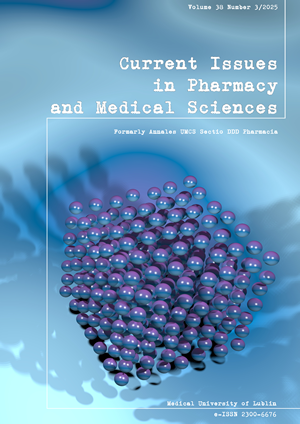Biofilm production and antibiotic resistance profilesof coagulase-negative Staphylococci isolatedfrom hospitalized patients
DOI:
https://doi.org/10.12923/cipms-2025-0026Słowa kluczowe:
antibiotic resistance, Staphylococcus epidermidis, coagulase-negative staphylococci, biofim, MRCoNSAbstrakt
Coagulase-negative staphylococci (CoNS) have emerged as significant opportunistic pathogens, particularly in hospital settings where they are increasingly implicated in healthcare-associated infections (HAIs). Biofilm formation and colonization on medical devices represents a pivotal determinant in the pathogenesis of CoNS infections, allowing them to adhere to both biotic and abiotic surfaces, evade immune responses and withstand antimicrobial treatments. This study aimed to determine the prevalence of biofilm formation among CoNS and examine its impact on antibiotic resistance using a modified microtiter plate method in clinical samples. Our findings reveal a 100% prevalence of biofilm formation among CoNS isolates, with strong biofilm in 43.33% of strains, moderate biofilm in 20%, and weak biofilm in the remainder. Among the strong biofilm-producing strains, 92.31% exhibited the MRCoNS resistance phenotype and 79.92% showed the cMLSb resistance phenotype. These results illustrate the growing threat posed by biofilm-forming CoNS to modern medicine and highlight the urgent need to develop advanced methods for combating biofilm-producing bacteria.
Bibliografia
1. Heilmann C, Ziebuhr W, Becker K. Are coagulase-negative staphylococci virulent? Clin Microbiol Infect. 2019;25(9):1071-80.
2. Asante J, Abia ALK, Anokwah D, Hetsa BA, Fatoba DO, Bester LA, et al. Phenotypic and genomic insights into biofilm formation in antibiotic-resistant clinical coagulase-negative Staphylococcus species from South Africa. Genes (Basel). 2022;14(1):104.
3. Schilcher K, Horswill AR. Staphylococcal Biofilm Development: Structure, regulation, and treatment strategies. Microbiol Mol Biol Rev. 2020;84(3):e00026-19.
4. Otto M. Staphylococcal biofilms. Microbiol Spectr. 2018;6(4):10.1128/microbiolspec.GPP3-0023-2018.
5. Vestby LK, Grønseth T, Simm R, Nesse LL. Bacterial biofilm and its role in the pathogenesis of disease. Antibiotics (Basel). 2020;9(2):59.
6. Papenfort K, Bassler BL. Quorum sensing signal-response systems in Gram-negative bacteria. Nat Rev Microbiol. 2016;14(9):576-88.
7. Cheung GY, Otto M. Understanding the significance of Staphylo-coccus epidermidis bacteremia in babies and children. Curr Opin Infect Dis. 2010;23(3):208-16.
8. Becker K, Heilmann C, Peters G. Coagulase-negative staphylococci. Clin Microbiol Rev. 2014;27(4):870-926.
9. Empel J, Żabicka D, Hryniewicz W. Ziarenkowce Gram-dodatnie z rodzaju Staphylococcus. Oznaczanie wrażliwości i wykrywanie mechanizmów oporności na antybiotyki β-laktamowe. Warszawa: Narodowy Instytut Leków; 2021.
10. Khashei R, Malekzadegan, Y, Sedigh Ebrahim-Saraie H, Razavi Z. Phenotypic and genotypic characterization of macrolide, lincosamide and streptogramin B resistance among clinical isolates of staphylococci in southwest of Iran. BMC Res Notes. 2018;11:711.
11. The European Committee on Antimicrobial Susceptibility Testing. Breakpoint tables for interpretation of MICs and zone diameters. Version 13.1; 2023. [http://www.eucast.org]
12. Stepanović S, Vuković D, Hola V, Di Bonaventura G, Djukić S, Cirković I, et al. Quantification of biofilm in microtiter plates: overview of testing conditions and practical recommendations for assessment of biofilm production by staphylococci. APMIS. 2007;115(8):891-9.
13. Wilson C, Lukowicz R, Merchant S, Valquier-Flynn H, Caballero J, Sandoval J, et al. Quantitative and qualitative assessment methods for biofilm growth: A mini-review. Res Rev J Eng Technol. 2017;6(4).
14. Rogers KL, Fey PD, Rupp ME. Coagulase-negative staphylococcal infections. Infect Dis Clin North Am. 2009;23(1):73-98.
15. Orazi G, Ruoff KL, O'Toole GA. Pseudomonas aeruginosa increases the sensitivity of biofilm-grown Staphylococcus aureus to membrane-targeting antiseptics and antibiotics. mBio. 2019;10(4):e01501-19.
16. Kitti T, Seng R, Thummeepak R, Boonlao C, Jindayok T, Sitthisak S. Biofilm formation of methicillin-resistant coagulase-negative Staphylococci isolated from clinical samples in Northern Thailand. J Glob Infect Dis. 2019;11(3):112-7.
17. Foka A, Chini V, Petinaki E, Kolonitsiou F, Anastassiou ED, Dimitracopoulos G, et al. Clonality of slime-producing methicillin-resistant coagulase-negative staphylococci disseminated in the neonatal intensive care unit of a university hospital. Clin Microbiol Infect. 2006;12(12):1230-3.
18. Wolcott RD, Rhoads DD, Bennett ME, Wolcott BM, Gogokhia L, Costerton JW, et al. Chronic wounds and the medical biofilm paradigm. J Wound Care. 2010;19(2):45-53.
Pobrania
Opublikowane
Numer
Dział
Licencja
Prawa autorskie (c) 2025 Autorzy

Praca jest udostępniana na licencji Creative Commons Attribution-NonCommercial-NoDerivatives 3.0 Unported License.


